Data:HWSD
HWSD dataset information page
Short Description
| Harmonized World Soil Database |
Statement: Harmonized World Soil Database (HWSD)
Abstract: The HWSD is a 30 arc-second raster database with over 16000 different soil mapping units that combines existing regional and national updates of soil information worldwide (SOTER, ESD, Soil Map of China, WISE) with the information contained within the 1:5 000 000 scale FAO-UNESCO Soil Map of the World (FAO, 19711981).
The resulting raster database consists of 21600 rows and 43200 columns, which are linked to harmonized soil property data. The use of a standardized structure allows for the linkage of the attribute data with the raster map to display or query the composition in terms of soil units and the characterization of selected soil parameters (organic Carbon, pH, water storage capacity, soil depth, cation exchange capacity of the soil and the clay fraction, total exchangeable nutrients, lime and gypsum contents, sodium exchange percentage, salinity, textural class and granulometry).
NEW UPDATE!!
26 March, 2009 - Version 1.1 now includes SOTER/SOTWIS data for The Democratic Republic of the Congo, Burundi, Rwanda, Senegal, and Gambia. (For a full description of HWSD updates through time, see the 'Download Data Only' link in the menu.)
HWSD DESCRIPTION
HWSD-coverThe Land Use Change and Agriculture Program of IIASA (LUC) and the Food and Agriculture Organization of the United Nations (FAO) have developed a new comprehensive Harmonized World Soil Database (HWSD). Vast volumes of recently collected regional and national updates of soil information were used for this state-of-the-art database. The work was carried out in partnership with:
* ISRIC-World Soil Information, together with FAO, were responsible for the development of regional soil and terrain databases and the WISE soil profile database; * the European Soil Bureau Network, which had recently completed a major update of soil information for Europe and northern Eurasia, and * the Institute of Soil Science, Chinese Academy of Sciences, which provided the recent 1:1,000,000 scale Soil Map of China.
The HWSD is of immediate use in the context of the Climate Change Convention and the Kyoto Protocol for soil carbon measurements and for the FAO/IIASA Global Agro-ecological Assessment study (GAEZ 2008), for which HWSD was developed in the first place. The HWSD contributes sound scientific knowledge for planning sustainable expansion of agricultural production to achieve food security and provides information for national and international policymakers in addressing emerging problems of land competition for food production, bio-energy demand and threats to biodiversity. map
The HWSD is a 30 arc-second raster database with over 16000 different soil mapping units that combines existing regional and national updates of soil information worldwide (SOTER, ESD, Soil Map of China, WISE) with the information contained within the 1:5 000 000 scale FAO-UNESCO Soil Map of the World (FAO, 19711981).
The resulting raster database consists of 21600 rows and 43200 columns, which are linked to harmonized soil property data. The use of a standardized structure allows for the linkage of the attribute data with the raster map to display or query the composition in terms of soil units and the characterization of selected soil parameters (organic Carbon, pH, water storage capacity, soil depth, cation exchange capacity of the soil and the clay fraction, total exchangeable nutrients, lime and gypsum contents, sodium exchange percentage, salinity, textural class and granulometry).
Reliability of the information contained in the database is variable: the parts of the database that still make use of the Soil Map of the World such as North America, Australia, West Africa and South Asia are considered less reliable, while most of the areas covered by SOTER databases are considered to have the highest reliability (Central and Southern Africa, Latin America and the Caribbean, Central and Eastern Europe).
Data format
| Data type: | Land Cover |
| Data origin: | |
| Data format: | BIL |
| Other format: | |
| Data resolution: | 30 arc second (~1km) |
| Datum: |
Data Coverage
Spatial data coverage: Global
Temporal data coverage: Time snap shot
Time period covered:
Availability
Download data: http://www.iiasa.ac.at/Research/LUC/External-World-soil-database/HTML/index.html?sb=1
Data source: http://www.iiasa.ac.at/Research/LUC/External-World-soil-database/HTML/index.html?sb=1
References
- FAO/IIASA/ISRIC/ISSCAS/JRC, 2009. Harmonized World Soil Database (version 1.1). FAO, Rome, Italy and IIASA, Laxenburg, Austria.

